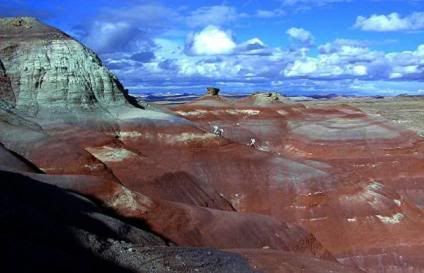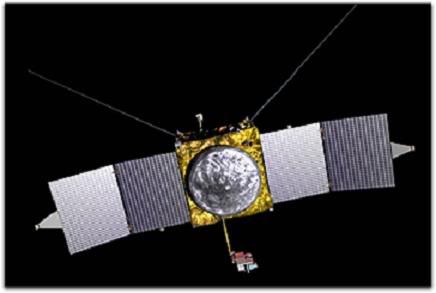Post by glactus on Nov 16, 2009 9:41:29 GMT
A Tale of Planetary Woe

Echus Chasma
Planetary scientists believe that waterfalls may have once cascaded down these steep cliffs at Echus Chasma on Mars. Mars has many desiccated landscapes like this one, thought to have been sculpted by abundant water in the distant past.

Mars billions of years ago
Once upon a time - roughly four billion years ago - Mars was warm and wet, much like Earth. Liquid water flowed on the martian surface in long rivers that emptied into shallow seas. A thick atmosphere blanketed the planet and kept it warm. Living microbes might have even arisen, some scientists believe, starting Mars down the path toward becoming a second life-filled planet next door to our own.

Ancient mars
But that's not how things turned out. Mars today is bitter cold and bone dry. The rivers and seas are long gone. Its atmosphere is thin and wispy,and if Martian microbes still exist, they're probably eking out a meager existence somewhere beneath the dusty Martian soil.

The landscape
What happened? Why did Mars dry up and Freeze over? These haunting questions have long puzzled scientists. A few years from now we might finally know the answer, thanks to a new orbiter NASA will send to Mars called MAVEN (short For Mars Atmosphere and Volatile Evolution).

Marven spacecraft
"The goal of MAVEN is to figure out what processes were responsible for those changes in the climate," says Bruce Jakosky, Principal Investigator for MAVEN at the University of Colorado at Boulder.
One way or another, scientists believe, Mars must have lost its most precious asset: its thick atmosphere of carbon dioxide. CO2 in Mars's atmosphere is a greenhouse gas, just as it is in our own atmosphere.
Over the last four billion years, Mars somehow lost most of that blanket. Scientists have proposed various theories for how that loss happened. Perhaps an asteroid impact blew most of the atmosphere into space in one catastrophic event. Or maybe erosion by the solar wind - a stream of charged particles emanating from the sun - could have slowly stripped the atmosphere away over eons. The planet's surface might also have absorbed the CO2 and locked it up in minerals such as carbonate.
MAVEN will be the first mission to Mars specifically designed to help scientists understand the ongoing escape of CO2 and other gases into space. The probe will orbit Mars for at least one Earth-year. At the elliptical orbit's low point, MAVEN will be 125 km above the surface; its high point will take it more tha n 6000 km out into space. This wide range of altitudes will enable MAVEN to sample Mars's atmosphere more thoroughly than ever before.
As it orbits, MAVEN's instruments will track ions and molecules in this broad cross-section of the Martian atmosphere, thoroughly documenting the flow of CO2 and other molecules into space for the first time.

Credits: These are NASA/ESA images. Mars express/ESA
See more at Mars daily.com.
www.marsdaily.com/reports/A_Tale_Of_Planetary_Woe_999.html

Echus Chasma
Planetary scientists believe that waterfalls may have once cascaded down these steep cliffs at Echus Chasma on Mars. Mars has many desiccated landscapes like this one, thought to have been sculpted by abundant water in the distant past.

Mars billions of years ago
Once upon a time - roughly four billion years ago - Mars was warm and wet, much like Earth. Liquid water flowed on the martian surface in long rivers that emptied into shallow seas. A thick atmosphere blanketed the planet and kept it warm. Living microbes might have even arisen, some scientists believe, starting Mars down the path toward becoming a second life-filled planet next door to our own.

Ancient mars
But that's not how things turned out. Mars today is bitter cold and bone dry. The rivers and seas are long gone. Its atmosphere is thin and wispy,and if Martian microbes still exist, they're probably eking out a meager existence somewhere beneath the dusty Martian soil.

The landscape
What happened? Why did Mars dry up and Freeze over? These haunting questions have long puzzled scientists. A few years from now we might finally know the answer, thanks to a new orbiter NASA will send to Mars called MAVEN (short For Mars Atmosphere and Volatile Evolution).

Marven spacecraft
"The goal of MAVEN is to figure out what processes were responsible for those changes in the climate," says Bruce Jakosky, Principal Investigator for MAVEN at the University of Colorado at Boulder.
One way or another, scientists believe, Mars must have lost its most precious asset: its thick atmosphere of carbon dioxide. CO2 in Mars's atmosphere is a greenhouse gas, just as it is in our own atmosphere.
Over the last four billion years, Mars somehow lost most of that blanket. Scientists have proposed various theories for how that loss happened. Perhaps an asteroid impact blew most of the atmosphere into space in one catastrophic event. Or maybe erosion by the solar wind - a stream of charged particles emanating from the sun - could have slowly stripped the atmosphere away over eons. The planet's surface might also have absorbed the CO2 and locked it up in minerals such as carbonate.
MAVEN will be the first mission to Mars specifically designed to help scientists understand the ongoing escape of CO2 and other gases into space. The probe will orbit Mars for at least one Earth-year. At the elliptical orbit's low point, MAVEN will be 125 km above the surface; its high point will take it more tha n 6000 km out into space. This wide range of altitudes will enable MAVEN to sample Mars's atmosphere more thoroughly than ever before.
As it orbits, MAVEN's instruments will track ions and molecules in this broad cross-section of the Martian atmosphere, thoroughly documenting the flow of CO2 and other molecules into space for the first time.
Credits: These are NASA/ESA images. Mars express/ESA
See more at Mars daily.com.
www.marsdaily.com/reports/A_Tale_Of_Planetary_Woe_999.html


